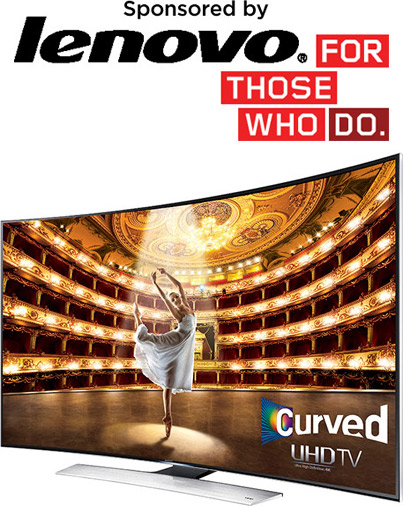Demystifying 4K / UHD television

The new UHD-TVs offer sharp, colorful pictures on a curved surface which both visually reduces their screen size and aids viewing in sunny rooms. PRIME submitted photo
By Gary M. Kaye
Editor, Tech50+ (
www.tech50plus.com)
The first time I saw a 4K television, also known as UHD for Ultra High Definition, was at the 2013 Consumer Electronics Show in Las Vegas, Nevada. Several of the major manufacturers – including Samsung, LG, and Sony – were touting them as the next big thing. And by the 2014 CES they were in fact even bigger, well at least in size if not popularity. There were screens as large a 108-inches diagonally, and some of them curved. The pictures were beautiful.
Is it 3D TV all over again?
But I was skeptical. After all, it was just a year or two earlier when the television makers were trying their best to sell us all 3D televisions. They promised that there would be a world of 3D programming available from 3D only cable channels. Quick, a show of hands – How many of you are watching 3D programs or movies at home using those bizarre glasses? That’s what I thought.
We got a great deal on a 65” 3D set. We watched about half a dozen 3D movies. Then the glasses went back into the entertainment console, and that was that. 3D came in different formats, and you had to adjust the glasses for each one: top and bottom split, left and right split, red and green. And that seldom worked right. So we gave up and felt burned.
A 4K “test drive”
Now the question is whether we’d all feel the same way about 4K television? Sure the picture was sharp, but there was (and still is) next to zero 4K content. That means that most of what you’re going to watch on that expensive 4K screen would be a doubly sharp version of the HD programming already out there (referred to by the industry as upscaling). Would that justify the price tag? And what about these big curved screens, were they just another gimmick?
The only way to find out was to try living with one. So in came a Samsung 78” curved UHD television. After it was set up it wasn’t the overwhelming monstrosity I imagined. (How many of us remember being happy with 19-inch as a big screen? And 25-inch as gigantic?).
After a couple of months of living with the set I will admit that my first impressions were somewhat incorrect. No, there is really not very much 4K content. The cable companies cannot transmit it. It would currently take two Blu-ray discs to play just one 4K movie. Sony sells a media server for its 4K televisions that will let you download studio titles via the Internet. Netflix and You Tube are providing content. Several companies, including Sony are making consumer, pro-sumer, and professional 4K cameras so you can create your own content. Imagine Johnny’s birthday party complete with Pin the Tail on the Donkey in dramatic 4K. Maybe not. My Samsung UHD-TV came with four titles on an external storage device, not one of which I would have paid money to watch. So that’s most of the bad news.
Here’s the good news. The picture is awesome. It is crisp, sharp, colorful, dramatic. And while there’s not much in native 4K yet, I do believe this time will be different. There will be 4K content. The industry has tentatively agreed on a new 4K disc standard. Eventually cable companies will probably figure out how to stuff all those ones and zeros into their wires. But in the meantime, just the improvement from standard HDTV is dramatic.
As for that curved thing. Turns out it really works for me. It doesn’t quite make me feel like I’m in an IMAX theatre. But my living room has a lot of glass and a lot of sun. Watching my 65-inch set in the daytime was challenging. The curved set dramatically reduces the reflected light hitting the screen, making it much easier to watch during the day, and even more dramatic at night.
The bottom line
Should you run out and buy a new 4K TV today? No – in another year or two there will be 8K TV coming to market, promising even more hype. But, the prices for 4K televisions are coming down, especially now that mid and lower tier manufacturers like Hisense and Vizio are in the game. And screen size has a lot to do with price. For example, the Samsung 78-inch set, model UN78HU9000F – 78-inch Curved LED-backlit LCD TV – Smart TV - 4K UHDTV (2160p) runs between about $5,650 and $6,000, while its 65-inch little brother, which is still pretty big, the UN65HU9000 - 65 LED Smart TV - 4K UHDTV (2160p) is available for between $2,650 and about $3,000 – or about half the price for a still pretty impressive experience. And that’s considerably less than a 65-inch 3D set cost just a couple of years ago.
If you are in need of a new television and intend to get one anyway – and if you can find a price point you’re comfortable with – I’d suggest you might buy a 4K. But if your current set is still serving its purpose, don’t trash it just yet. The picture on 4k sets is beautiful, and discernably better than current HD. But you should not be buying it now for today’s sparse 4K content.
It is coming, but it’s not here yet.
Gary Kaye is the creator of Tech50+ ((www.tech50plus.com)), the leading website covering technology from the Baby Boomer perspective. Kaye has been covering high tech for more than 30 years with outlets including NBC, ABC, CNN and Fox Business. He is a regular contributor to AARP and other websites on issues regarding the nexus of technology, seniors and baby boomers.

